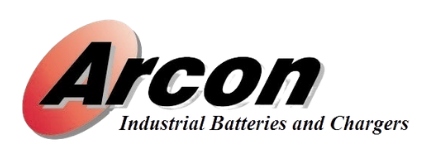Chargers are a key component in the electric forklift truck power package. An equipment dealer who neglects the charger details runs the risk of not only losing the sale, but also ruining the battery. Consider this: many times the charger included in a “complete package& may not be the appropriate unit for the battery – and it won’t take long for the end user to notice.
Always read the charger nameplate for the Ampere–Hour specification to see that it is the right size for the intended job. The nameplate will usually show a range of appropriate battery sizes, but if it doesn’t, the manufacturer or a trained charger serviceman can provide the range information. Many chargers allow some adjustment of at least the starting current, and for chargers that taper to a low finish rate (ferro–resonant designs), it is possible to make adjustments that allow you to charge a very wide range of battery capacities with a single model of charger.
Keep in mind that most chargers are nameplate–rated for an 8–hour charge cycle after plugging in a 100% discharged battery. Significantly larger batteries can be charged if the user has more than one shift available for charging, or if the battery is not fully discharged when plugged into the charger. But watch out: batteries designed to operate with higher than customary acid strength require a more vigorous finish rate, and they do not do well with an undersized charger. In fact, some high–performance batteries should not be charged on a ferro–resonant charger at all. If you have any doubts about matching a charger to your battery, contact the battery manufacturer. It is a good idea to trade in a questionable charger for one that has an expert’s approval.
Use care and make only well-informed changes to any charger settings. Usual starting rate current is 18–20 Amps per 100 A.H. of battery capacity, with a finish rate (at the end of the charge cycle) of approximately 4 A./200 A.H. (high performance battery types may have different needs– consult the manufacturer).
What can and can not be adjusted to suit your battery and customer needs? These following are not adjustable:
- AC input phase requirements
- Battery voltage rating. If, for example, the nameplate identifies the charger as a 36–volt battery charger only, it can not be set to charge a 24volt or 48volt battery.
- Maximum DC output current rating
But you can change:
- AC input voltage. Most large industrial battery chargers can be set for 208 through 480 volts AC.
- DC output starting current (at intervals below max output rating).
- In some cases, finish rate current may be adjustable, as well as taper or slope of the voltage–current curve. This must be done “by the book”.
- Timing of the charge cycle can be changed by replacing the timer or adding a microprocessor auto control.
- Output cable length and connector type can be customized.
How to order a charger: If you are an equipment dealer, ask the end user these questions.
- Do you have 3–phase power?
- What AC voltages (exactly) are available in the charging area?
- What size is the battery? (voltage and A.H.)
- Will this charger be used to charge additional batteries of the same voltage? What are their A.H. capacities?
- How much uninterrupted charging time is available?
- What type of connector is required (style, amp rating, and color code)?
Relay the answers to the above questions to your charger supplier. If you are seeking a used charger, insist on a refurbished, fully adjusted and recalibrated charger that meets original factory specifications. Used chargers, even if they have just been removed from service, must be “tuned up” before resale to ensure proper battery performance and optimum life. It is the charge cycle itself that has the largest impact on battery wear and tear, and improper settings or malfunctioning charger components can significantly reduce battery life. Keep in mind that the charger may have contributed to the failure of the battery in its former application, and that may be the reason it is on the market now.
If you are purchasing battery chargers for resale to lift truck customers, you can improve the odds for both you and the end user by:
- Buying from someone who can assure you of proper charger operation.
- Avoiding obsolete charger designs with complex circuitry.
- Ensuring that AC input taps are set to match the customer’s line voltage, and that voltage setting is clearly marked on the unit.
- Replacing cut or damaged charger cables and connectors.
- Making sure that internal heat-sinks and transformers are free of dirt and dust (they must be able to shed heat, and dirt acts as an insulator).
One of the most trouble–prone parts of older used chargers is the timer/80% relay circuit. If this fails, the battery will either be chronically undercharged or overheated. Painstaking adjustments to this part of the charger can be avoided by eliminating these electromechanical parts and installing a microprocessor charger control. Your charger expert can provide details on this approach to giving an older charger top performance capability.
For more information, contact Arcon Equipment Inc. (440) 232-1422.
